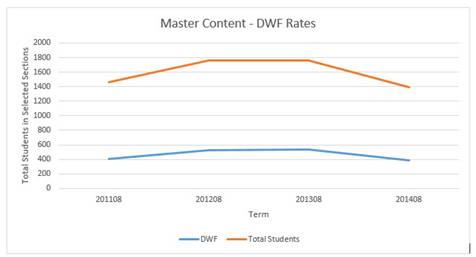Update on Strategy 4:
|
High Impact Strategy |
Strategy 1: Online Support Strategy 2: Online Content |
||||||||||||||||
|
Related Goal |
Goal 8: Enhance instructional delivery and student services to support educational excellence and student success. |
||||||||||||||||
|
Summary of Activities |
Strategy 1: During the fall 2014 semester, 64% of DSC students participated in distance education by taking at least one online class, and 34% of DSC students were fully online. To more effectively serve the student population, Online Support Specialists (OSS’s) were assigned to fully online students in each major area of the Institution. These Online Support Specialists provided specialized support to this student population, which included but was not limited to, assistance with admissions, advising, registration, course navigation, and proctored testing. Number of "online only" students
Additionally, in fall 2013 approximately 17% of the total credit hours taken were garnered from students taking classes solely online. The support specialists utilized an ACCESS database to track the number and type of student contacts for the semester. This data was analyzed to assist in identifying potential gaps in student support for fully at-a-distance students. Strategy 2: DSC contracts with select full-time faculty who, as content experts, create MasterShells([2]) for specific disciplines, mentor new and adjunct faculty, and review courses periodically throughout the semester. This online lead designer/faculty program ensures that MasterShells cover all required learning objectives, meet DSC’s standards for academic rigor, and assist student success by providing a well-organized course structure. |
||||||||||||||||
|
Baseline Status |
Strategy 1:
Strategy 2:
|
||||||||||||||||
|
Interim Measures of Progress |
Strategy 1: Between September 1, 2014 and December 3, 2014, 2,720 contacts were made of which 1,614 were unduplicated student contacts. Eighty-two percent of the contacts dealt with direct course concerns ranging from advising and proctoring questions to course navigation issues. Only 3% of the contacts were specific to academic services such as online tutoring or other academic support. While 79% of the attempted online credit hours for fall 2015 were successfully completed, the online learning division will continue to take proactive steps to ensure that fully at-a-distance students are aware of academic support services available to them. This will include additional contacts through email, phone calls, and webinar sessions, which should further increase the percentage of successfully completed online credit hour attempts in future semesters. Strategy 2: The online learning division has worked diligently to create MasterShell content for specific core classes and to assign mentors to new online faculty members and online adjuncts. MasterShell content ensures that learning objectives and assessment criteria are included in the course content and that they meet DSC’s standards for academic rigor. Online Learning implemented the use of MasterShells fall 2012. Content has been developed for sixteen courses, which are routinely staffed by adjunct faculty. Full-time faculty members may choose to use the master content, but adjunct faculty are required to use the content as a base shell. During any given fall term, 60 to 130 online sections utilize MasterShell content. DWF rates tracked from fall 2011 (baseline data) through fall 2014 demonstrated a disappointing increase from 2011 to 2013, with a decline from 2013 to 2014. The Online Division is cautiously optimistic that the approach may be demonstrating some benefit. Additional monitoring will need to be done before any firm conclusions can be made. Furthermore, an in-depth analysis should be performed to determine inconsistencies in data, define student characteristics, and identify gaps in curriculum development and delivery decisions. |
||||||||||||||||
|
Overall Measures of Success |
Strategy 1:
Strategy 2:
|
||||||||||||||||
|
Lessons Learned |
The Online Learning Division continues to work with Enrollment Management teams to track online student populations. DSC has opted to use parameters other than student course load to assign the student campus code in Banner, which continues to make tracking online only students a challenge. In an attempt to identify online only students, a student attribute code was created and key Admission and Registrar staff were asked to ensure the code was applied correctly to student records. There remains a learning curve regarding the student attribute code, and RPG numbers for online only students remain difficult to disengage from the overall student population. |


